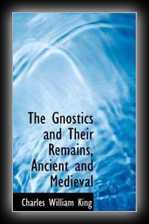
The Gnostics and Their Remains, Ancient and Mediaeval
by C.W. King, M.A.
1887
Astrology justly claims for her own a large share of the relics popularly called Gnostic; for Gnosticism, from the beginning, had linked its own speculations to those of the Magians' national science, and borrowed as a vehicle for its own peculiar ideas the machinery of the latter--its Astral Genii, Decani, and Myriageneses. And this truth was seen by the earliest writers upon Gnosticism, for Hippolytus proves conclusively, at much length, that the system of the Peratae (a branch of the Ophites) was nothing more than a barefaced plagiarism from the rules of Astrology. Under this head I have endeavoured to separate the purely Astrological talismans from those to which the illuminati, their makers, had given a more spiritual sense. "Astrology, not Christ, is the author of their religion," says Hippolytus of the sects founded by Euphrates and Celbes; and proceeds to give extracts from their writings, held in the highest esteem at the time, which amply bear out his assertion.
Next pour in, a multitudinous swarm, the stones covered over with long strings of bare inscriptions, genuine offspring of the Kabbala, that betray the handiwork of the idol-hating Jewish dreamers of Alexandria--spells even then ascribed to Solomon, and which secured the favour
"Of those demons that are found
In fire, air, flood, or under ground;
Whose power hath a true consent
With planet or with element."
Related to this religion by their nature are talismans and amulets in general; for Gnostic symbols and Gnostic formulae gave their virtue to many of the class: being borrowed either directly from the Gnosis, or from the older creeds out of which the latter was constructed. Their employment, and the notions generating them, have been here described; showing the derivation of many of the mediaeval examples from the Gnostic class; and by following out the same principle it has been attempted to find a key to their cabalistic legends, which may fit them better than any hitherto offered by their interpreters--symbols and emblems being with them those conveying the idea of death…
Last to be considered comes the Gnosis in its final and grandest manifestation, the composite religion of Manes: with its wonderful revival and diffusion over Mediaeval Europe; and its supposed connexion with the downfall of the Templars, of which catastrophe the history and causes are here briefly sketched; although to form a satisfactory judgment on the merits of the case is about the hardest problem history can offer. With their scandal and their fate is coupled the most singular phenomenon of modern times--the preservation by their professed descendants, the Freemasons, of so much symbolism that appears to be indisputably Gnostic in its origin.
